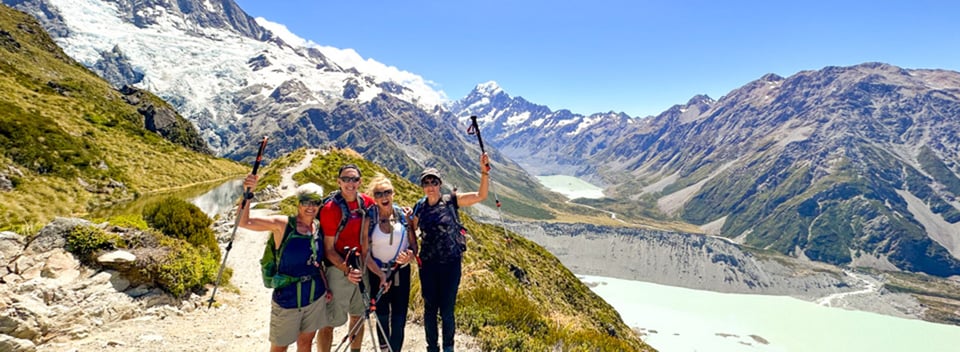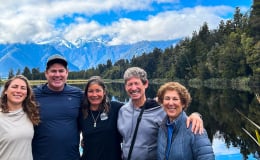
The Ultimate Guide to Hiking in New Zealand

Here at New Zealand Trails, our team have years of experience running guided hiking trips around New Zealand. With small groups of international adventurers joining us from all walks of life, we make sure our hiking trips are the ultimate way to experience New Zealand.
We’re also a bunch of keen hikers and outdoor enthusiasts ourselves, and of course, our guides are all ambitious hikers. With that in mind, we wanted to take this opportunity to share our local knowledge and expertise about hiking in New Zealand. Whether you’re thinking of joining us for a guided trip or planning to go it alone, you’re sure to find this information useful. As a fellow outdoor person, you’re part of our tribe – whether you’re new to hiking or a seasoned expert.

When to hike in New Zealand
The New Zealand hiking season is at its best from October through until April. Outside of these times you need to be an expert as most of the hiking trails are snow-covered, especially in the high Alps.
If you visit during these months, you’ll probably see our groups with their local guides exploring New Zealand, taking on the country's best hikes and enjoying other adventures. It’s our mission to share the best New Zealand has to offer. With great food and accommodation making up the package, it’s easy to see why there are so many smiles on our guests faces!

Planning and preparation - the importance of booking ahead
New Zealand has 10 named Great Walks that journey through the country's most magnificent and iconic places, as well as many other long hiking trails. The 10 Great Walks get very busy in the summer months and the huts book up quickly. If you’re hoping to hike one of the Great Walks you will need to plan ahead and book before you arrive to secure your permits and overnight hut passes.
If you just turn up and hope to get a place you may be disappointed, even if you are flexible with your dates. The Milford, Abel Tasman and Routeburn tracks in particular book up months in advance.
These are the 10 Great Walks in New Zealand. Of course, this doesn’t mean hiking less well-known trails is any less ‘great’ and in fact, you may find them less busy during the summer months.
- Lake Waikaremoana Great Walk – East Coast
- Tongariro Northern Circuit – Central North Island
- Whanganui Journey – Manawatu/Whanganui
- Abel Tasman Coast Track – Nelson/Tasman
- Heaphy Track – Nelson/Tasman, West Coast
- Paparoa Track and Pike29 Memorial Track – West Coast
- Routeburn Track – Otago, Fiordland
- Kepler Track – Fiordland
- Milford Track – Fiordland
- Rakiura Track – Southland
How to book
You can book most trail permits yourself online through the website of the Department of Conservation. They have offices and visitor centres located all over the country where you can collect your pre-booked permits, make bookings and get valuable local advice once you get here.
If you’d prefer a guided hiking experience with a local guide, take a look at our hiking-based itineraries here or get in touch. New Zealand Trails run fully supported tours, designed to make your New Zealand adventure as easy and safe as possible. Your guide will be at your service for the entire duration of your trip, not only during hikes and other activities but also at any other time of the day too. It’s like having a local friend on hand at all times! A big part of travelling with one of our guides is that they can provide a great deal of knowledge each day, giving you the opportunity to learn all about New Zealand's fascinating environment.
What to pack for hiking in New Zealand
So where do you start with packing for a hike where you might experience four seasons in one day? Well, it’s all about layering! Make sure you have layers to put on and take off as the day progresses or the weather changes. You’ll also need to make sure you are carrying suitable food, drink, equipment and communication devices if you’re not with a guide.
If you opt to go for a guided trip like those operated by New Zealand Trails, your guide will provide and carry much of the group equipment on your hikes. If you're joining us on our Kiwi Classic trip, equipment like sleeping bags, mats and walking poles are available to save bringing them from home. A full detailed kit list will be sent to you when you’ve booked your trip.
For more information on what to pack, check out our Ultimate Packing Guide.

Who to hike with
Always hike with a friend or group that you know and trust. Even better, if you’re visiting from overseas, go with a company that provides you with a reliable guide who knows the route and can offer local knowledge, trusted back-up in the event of an emergency and even help carry some of the gear. Perfect!
If you are hiking with friends, be aware of how fit and experienced everyone is. You’ll need to pace yourself at the slowest person’s speed. Ensure everyone is part of the planning, so they know what they are doing and exactly what to expect. Make sure you know about everyone’s medical requirements before you go. Carry out a group kit check before you set out – has everyone got the right gear? Share out group items to spread the weight. Have a quick skills session before you go - do you have all the skills you’ll need in the group when it comes to the hiking terrain, navigation or any potential river crossings?
Thinking of hiking alone? One word. Don’t! Hike with a friend or a group. You can still experience serenity and alone time, but having company means you will be at your safest.
Leaving intentions - tell someone where you're going
Always, always, always share your plans. If you are planning your own hikes, the Mountain Safety Council of New Zealand has a simple planning tool online that creates a handy PDF for you to easily share with your loved ones about your intentions. It can be shared instantly on Facebook or emailed, and is quick to create. It is commonplace in NZ to do this and is at the heart of keeping you safe. The only way anyone will know to come and find you is if you don’t come back on time.
Many of the outdoor locations you will be hiking are remote and have no mobile phone coverage. Even if you think you aren’t going far, you may find you don’t have a phone signal. You may also find that away from the main trails, even in the high season, there are often very few people around. If something does go wrong, the only way our emergency services can help you is if they know you haven’t returned. You MUST tell a trusted family member or friend. If you’re visiting from overseas and your trusted contacts are back at home – no worries! You can still tell them your plans.
What do you need to tell your trusted person?
- What you are doing
- Where you are going
- Who is going with you
- What equipment you have with you
- What transport you are using
- When you are expecting to be back
- What to do if they don’t hear from you at the agreed time
Check the weather
You may think New Zealanders are obsessed with the weather and maybe we are just a little bit… we keep an eye on the forecast all the time to make sure we don’t get caught out! The Mountain Safety Council report that New Zealand’s changeable weather conditions frequently catch out those who are unprepared. So, it's super important that you check any weather watches and warnings for your region. Always check the mountain and rural forecasts for the region you're going as they can be quite different than an urban forecast for a major town or city. Metservice provides the best local weather forecasts and is the go-to place for accurate and up to date information.
The outdoor safety code
Adventuresmart NZ name five simple rules to help you stay safe in the great New Zealand outdoors:
Plan your trip - Seek local knowledge and plan the route you will take and the amount of time you can reasonably expect it to take.
Tell someone - Tell someone your plans and leave a date for when to raise the alarm if you haven’t returned.
Be aware of the weather - New Zealand’s weather can be highly unpredictable. Check the forecast and expect weather changes.
Know your limits - Challenge yourself within your physical limits and experience.
Take sufficient supplies - Make sure you have enough food, equipment, clothing and emergency rations for the worst-case scenario. Take an appropriate means of communication.
Remember that New Zealand is very different to anywhere else. Do not expect the same things as you might expect at when hiking at home. For example, mobile phone coverage is very sporadic – this is not a densely populated country. Likewise, if you are travelling out of the high season or in a remote area, you may not see anyone else. Stick with your hiking buddy, stay on the trail and make sure you are well prepared.
Alternatively, if you are unfamiliar with New Zealand then we recommend you opt to travel with an experienced operator with well-trained and knowledgeable guides, such as New Zealand Trails. If you'd like to find out more about our all-inclusive New Zealand adventures grab a copy of our FREE BROCHURE or get in touch - we'd love to chat.










